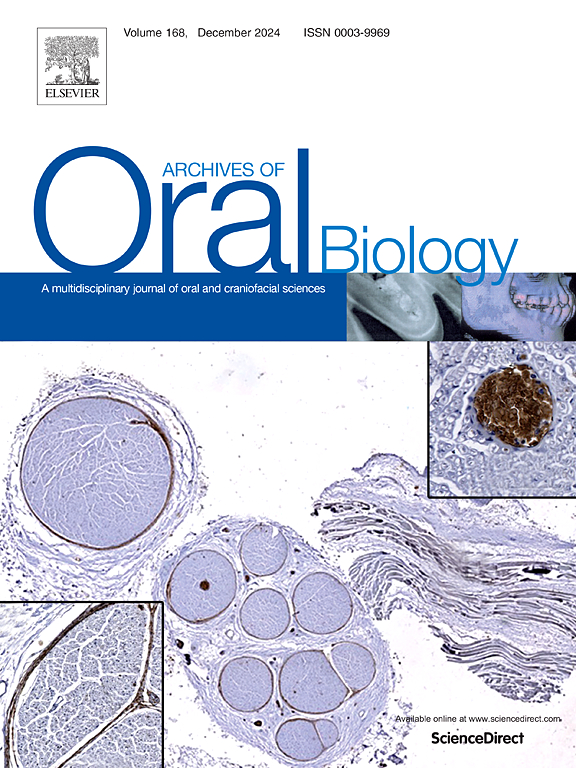内源性大麻素系统在牙周炎:系统回顾和计算机分析。
IF 2.1
4区 医学
Q2 DENTISTRY, ORAL SURGERY & MEDICINE
引用次数: 0
摘要
目的:本系统综述结合计算机研究探讨了内源性大麻素系统(ECS),特别是CB1和CB2受体(分别为CNR1和CNR2基因)在牙周健康和疾病(PD)中的作用。方法:检索PubMed/MEDLINE、Embase、Web of Science、Scopus和The Cochrane Library数据库,检索截至2024年8月发表的有关牙周炎和ECS的研究。GSE16134数据集用于差异基因表达分析、ECS基因相关性分析、生物标志物评估和功能富集分析。结果:9项研究符合纳入标准(3项临床研究和6项临床前研究)。临床研究表明,牙周炎患者CNR2基因表达显著降低,而CNR1基因表达变化较小。在动物实验中,通过不同的治疗方法激活CB2可以增加受体表达,减少促炎细胞因子,减轻牙槽骨丢失。CB1激活还能减少炎症和骨质流失。大麻素受体的内源性配体Anandamide (AEA)表现出抗炎作用,治疗后内源性水平降低。生物信息学分析显示,CNR1在PD组织中的表达与参与b细胞活化和体液免疫反应的基因呈正相关。相比之下,CNR2的表达与免疫调节和细胞外基质重塑相关的基因有很强的相关性,这表明CB1和CB2在牙周炎症中具有不同但互补的作用。结论:ECS参与牙周炎症,CB2激活成为一个有希望的治疗靶点。本文章由计算机程序翻译,如有差异,请以英文原文为准。
Endocannabinoid system in periodontitis: A systematic review and in silico analyses
Objective
This systematic review with in silico investigation discusses the involvement of the endocannabinoid system (ECS), particularly CB1 and CB2 receptors (genes CNR1 and CNR2 respectively), in periodontal health and disease (PD).
Methods
PubMed/MEDLINE, Embase, Web of Science, Scopus, and The Cochrane Library databases were searched for studies on periodontitis and ECS published up to August 2024. The GSE16134 dataset was used for analyses of differential gene expression, correlation of ECS genes, evaluation of biomarkers and functional enrichment analysis.
Results
Nine studies met the inclusion criteria (three clinical and six preclinical studies). Clinical studies demonstrated that CNR2 gene expression was significantly reduced in periodontitis, while CNR1 showed minor changes. Animal studies with CB2 activation by different therapies increased receptor expression, reduced pro-inflammatory cytokines, and mitigated alveolar bone loss. CB1 activation also reduced inflammation and bone loss. Anandamide (AEA), an endogenous ligand of the cannabinoid receptors, exhibited anti-inflammatory effects, with endogenous levels decreasing after therapy. Bioinformatics analysis revealed that CNR1 expression in PD tissues was positively associated with genes involved in B-cell activation and humoral immune responses. In contrast, CNR2 expression showed strong correlations with genes related to immune regulation and extracellular matrix remodeling, suggesting distinct yet complementary roles for CB1 and CB2 in periodontal inflammation.
Conclusions
The ECS participates in periodontal inflammation, with CB2 activation emerging as a promising therapeutic target.
求助全文
通过发布文献求助,成功后即可免费获取论文全文。
去求助
来源期刊

Archives of oral biology
医学-牙科与口腔外科
CiteScore
5.10
自引率
3.30%
发文量
177
审稿时长
26 days
期刊介绍:
Archives of Oral Biology is an international journal which aims to publish papers of the highest scientific quality in the oral and craniofacial sciences. The journal is particularly interested in research which advances knowledge in the mechanisms of craniofacial development and disease, including:
Cell and molecular biology
Molecular genetics
Immunology
Pathogenesis
Cellular microbiology
Embryology
Syndromology
Forensic dentistry
 求助内容:
求助内容: 应助结果提醒方式:
应助结果提醒方式:


